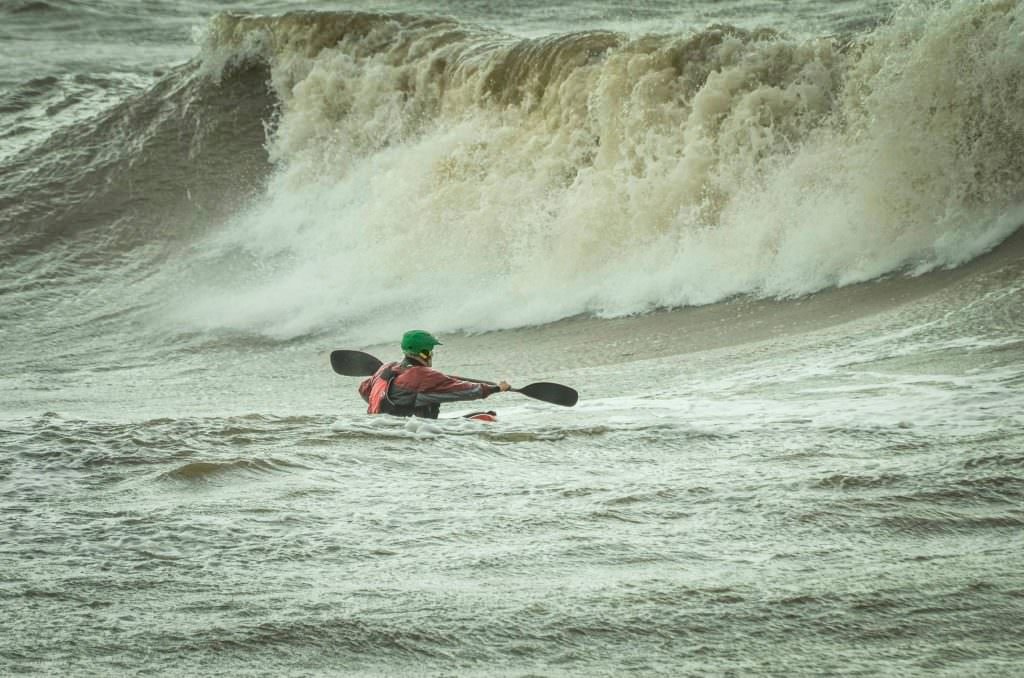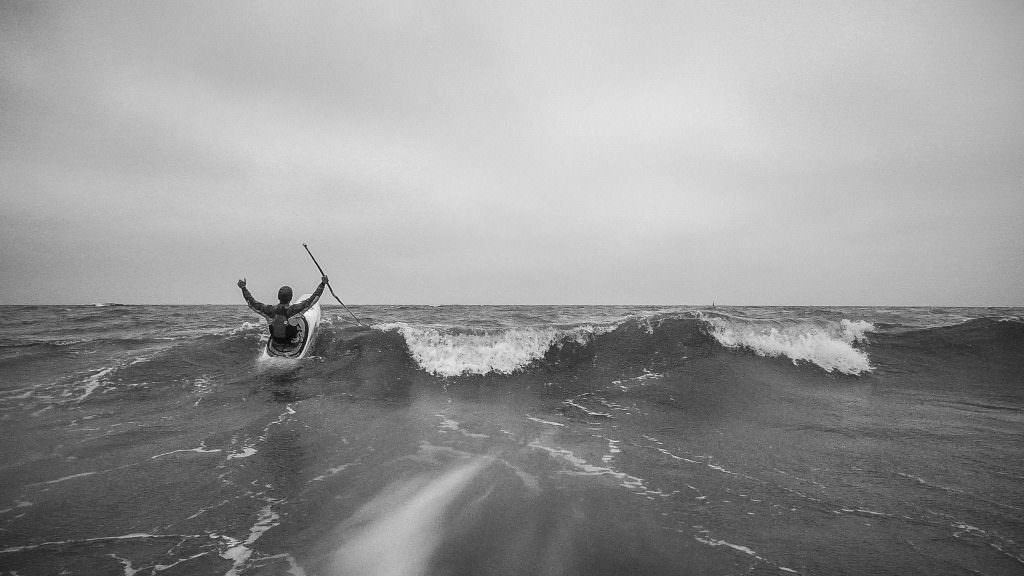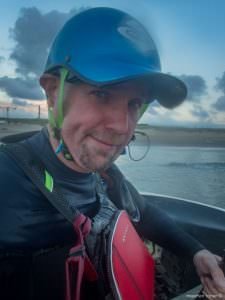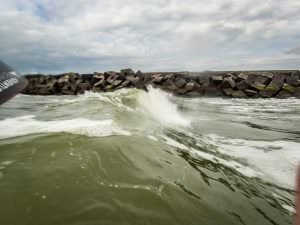
Priority change
In 2013 I discovered something that has changed my life: Surf kayaking. It might be the midlife crisis, an excuse to get out of the house or just getting bored with being behind the camera. Whatever it was: After three decades of shooting other people doing cool things, it was time for my own adventures. I had bought an inflatable kayak, hoping it would help rescue my deflated relationship. But paddling canals and little mosquito invested waters just didn’t do the trick. So I tried to find another way to make it a bit more exciting: take the big inflatable to the sea! Here is the actual moment I tried paddling rough waves, shot by my dad with the Olympus XZ1 I gave him for his birthday.
Surfs Up
It didn’t take much to realise this wasn’t the right boat for this type of activity, despite the top deck that was supposed to be closed I ended up with about 80 litres of water inside. Not that it made any difference, it made the whole thing a bit more stable in fact. Time to look around the interweb and find a more suitable option. A week later I was paddling at Rein Hagenaars surf school very close to where I tried my first inflated attempt. The very first session was brutal, it was just a 20 kilo sit on top trying to punch through the massive shore breakers, it took 90 minutes to get through to the other side where I ended up in this surreal ever-changing landscape or peaks and valleys. That day the waves were huge: 3 meters walls of water! Rein was sitting in his kayak on top of one of those peaks and shouted down to me with his arms stretched: “Welcome to my world!” and at that moment, I thought: This is what I’m going to do with the rest of my life. Little did I know that so far this turns out to be true, even more than I could have imagined.

Rein Hagenaars, a big inspiration for a lot of kayak surfers.
After 18 months of practising, learning how to roll a kayak and going on whitewater course in France I discovered my local beach Scheveningen Zuid. After all the training I felt secure enough to go at it alone, the waves were not as big or overwhelming: It had the perfect waves to learn the technique. The hook of Holland where I spend the every Sunday for the first 18 months was big, crazy and sometimes overpowering. You learn endurance and thrashing down a wave, but you don’t really learn how to surf.

Rein Hagenaars punching through a shore-breaker at Hook of Holland

safety first
Scheveningen
Not that the waves in Scheveningen can’t be big, I faced some real monsters, close to 5 meters, so big the first part you are freefalling a meter if not two before you hit the water. But most of the time they were easier to get through and had more shape, and, not unimportant, instead of driving 45 minutes to get there plus another 15 to carry the kayak to the water, it was a 8 minute ride and the beach is a lot smaller. The other added bonus: it has two massive harbour piers you can hide behind depending on the wind direction.

The harbour pier in the background creates a point break at low tide.
Because the south beach is pretty shallow you get a surfable wave most of the time and it’s not as crowded either. There are also several sandbanks to pick and choose from so it’s easy to stay away from the surfers who, depending on their skill level, don’t catch as many waves as you do with a big paddle.
The last thing you want is to end up being a wave-hog and catching everything in front of people, it’s not going to make you very popular. It’s already weird enough you sit there in full protection gear with a life vest, helmet and a big stick.
Four years ago I started out in a plastic whitewater: the Jackson SuperFun, technically it’s a river runner and it turned out to be a pretty good surfer as well. It was great to get through the extreme shore-breakers, very stable and easy to control. The good part: it’s a massive adrenaline filled workout and because the beach was only 8 minutes from my home I went as often as possible. Going crazy for 3 or 4 hours enjoying the power of the sea and in some cases simply trying to survive something you have absolutely no control over.
Because the plastic SuperFun doesn’t have any fins or a really nice surf shape you get pushed around, in big waves you end up spinning around instead of surfing them. A lot of fun, but with the more technical waves in Scheveningen, I found that learning to surf them properly was more enjoyable. At the end of the summer when the big storms hit the coast we can get massive waves, almost impossible to surf properly but great for a whitewater kayak:

Bouncing down the massive storm waves at Scheveningen south beach
Update
In 2015 Surf buddy Bart had joined me in Scheveningen and soon we ran into Pete, a kiwi who had an impressive collection of true Mega surf kayaks. Bart was surfing the RPF Master, a Portugees sit on top surfer with three fins and massive side rails to grab to waves and surf straight lines: it is a speed demon.

Borrowed the RPF Master in 2016
Time to upgrade
After trying the RPF master and finally experiencing the true surfing potential of a real surf kayak I bought Barts backup Master he brought over from Portugal, a very pretty blue one. This took surfing to another level, in fact, it took it from bouncing down the waves attempting to surf down the line to truly surfing a wave. There is something magical about the ever-changing face of the sea, it is never the same, always surprising and many times magical:
Especially early morning sessions when you see the sunrise over the dunes and the last of the storm waves come rushing in like melted glass performing a dance in front of you. There is nothing predictable about it and it always feels special to be part of those moments, even in those big fights to get through the first waves to find the surf wave you feel alive, part of something big and out of your control.
Paddle forever
It is also an unending lesson, after four years I feel like I’m just starting to get the basics right, no matter how much fun it has been to get to this point: it’s only been practice and truly learning how to surf a wave is still the big challenge. The next big step is going to other countries with really big Ocean waves, not these soft little wind waves, but true ocean power! There I can practice bottom turns, top turns, cutbacks and just have fun on waves that last longer than 4 seconds! I think surfing has become a big part of my life, it helps in so many ways: you have something that let you live in the moment, even if it is just a few seconds there is nothing else going on when you drop down a big wave and surrender to the power of the sea. No matter who you are, what you think you have accomplished: the wave doesn’t care, it is going to the shore no matter what you want. It is the great equalizer and in many ways the perfect way to get a healthy perspective on your life and choices.
Fun at all levels
You don’t have to be good at it to enjoy, the power of the fully operational sea is just a rush no matter if you surf down a tiny little wave. All you have to do is look at the kids having fun the very first time they try kayak surfing, it is the sport where everybody is smiling no matter how good you are. Go surfing dude, it’s awesome!
[envira-gallery id=”1536″]
Thanks
Even though this is not something you do as a team, it is a sport that you can’t do without other people, so thanks to Rein Hagenaars for his no-nonsense inspiration, Bart and Pete for making Scheveningen fun and getting me on real surf kayaks. And Pascal, Arjan and Paul for giving me advice and selling me the right gear.

